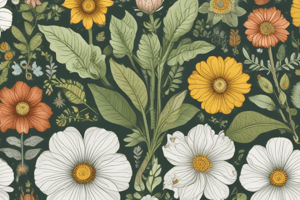Podcast
Questions and Answers
There are approximately 390,000 plant species known to science.
There are approximately 390,000 plant species known to science.
False (B)
Petals and sepals help attract pollinators.
Petals and sepals help attract pollinators.
True (A)
The carpel is the male part of the flower.
The carpel is the male part of the flower.
False (B)
Pollination occurs through the transfer of pollen from the male anther to the female stigma of the same flower.
Pollination occurs through the transfer of pollen from the male anther to the female stigma of the same flower.
Flowers pollinated by wind have structural differences from those pollinated by pollinators.
Flowers pollinated by wind have structural differences from those pollinated by pollinators.
Fertilization results in the production of fruits.
Fertilization results in the production of fruits.
A mature pollen grain contains three male cells.
A mature pollen grain contains three male cells.
The endosperm provides starchy food for the seed to grow.
The endosperm provides starchy food for the seed to grow.
Fruits and seeds are dispersed by humans only.
Fruits and seeds are dispersed by humans only.
The ovary remains the same size after fertilization.
The ovary remains the same size after fertilization.
Flashcards are hidden until you start studying
Study Notes
Sexual Reproduction in Plants
- There are approximately 390,900 plant species known to science, and sexual reproduction is a key factor in this diversity.
Parts of a Flower
- Petals and sepals help protect the flower bud and can be brightly colored or scented to attract pollinators.
- The stem and receptacle connect the flower to the rest of the plant.
- The stamen is the male part of the flower, consisting of an anther where pollen is produced and the filament, which is the stalk that supports the anther.
- The carpel is the female part of the flower, consisting of the stigma, style, and ovary.
- The stigma is a sticky landing for pollen, the style is where the pollen grain descends, and the ovary is where the female gametes or ovules are located.
Pollination
- Pollination is the transfer of pollen from the male anther of one flower to the female stigma of another flower.
- Flowers can be pollinated in different ways, including by wind, water, or pollinators such as insects, birds, and other animals.
- Flowers pollinated by pollinators are structurally different from those pollinated by wind or water, with differences in size, scent, and color of petals, and positioning of stamen and style.
Fertilization
- Fertilization results in the production of seeds.
- A mature pollen grain containing two male cells lands on the female stigma of the same species, grows a pollen tube, and travels down to the ovary, where it enters through an opening called the micropile.
- One male cell fuses with the female egg, fertilizing it, and develops into the seed.
- The other male cell attaches to two cells in the embryo sac, forming an endosperm, which provides starchy food for the seed to grow.
Dispersal of Fruits and Seeds
- The ovary enlarges and becomes a fruit, surrounding the internal seeds.
- Fruits and seeds are dispersed in many ways, including by humans, where they will again grow into a new plant under the correct conditions.
Sexual Reproduction in Plants
- Approximately 390,900 plant species are known to science, and sexual reproduction is a key factor in this diversity.
Parts of a Flower
- Petals and sepals protect the flower bud and attract pollinators with bright colors and scents.
- The stem and receptacle connect the flower to the rest of the plant.
- The stamen consists of an anther, which produces pollen, and a filament that supports the anther.
- The carpel is the female part of the flower, comprising the stigma, style, and ovary.
- The stigma is a sticky surface for pollen, the style allows pollen grain descent, and the ovary contains female gametes or ovules.
Pollination
- Pollination involves the transfer of pollen from the male anther to the female stigma of another flower.
- Flowers can be pollinated by wind, water, or pollinators like insects, birds, and other animals.
- Flowers adapted for pollinators have distinct structures, including size, scent, and petal color, and positioning of stamen and style.
Fertilization
- Fertilization produces seeds.
- A mature pollen grain grows a pollen tube, traveling down the style to the ovary, where it enters through the micropile.
- One male cell fuses with the female egg, fertilizing it, and develops into a seed.
- The other male cell forms an endosperm, providing starchy food for seed growth.
Dispersal of Fruits and Seeds
- The ovary enlarges and becomes a fruit, surrounding internal seeds.
- Fruits and seeds are dispersed through various means, including human activity, leading to new plant growth under suitable conditions.
Studying That Suits You
Use AI to generate personalized quizzes and flashcards to suit your learning preferences.




